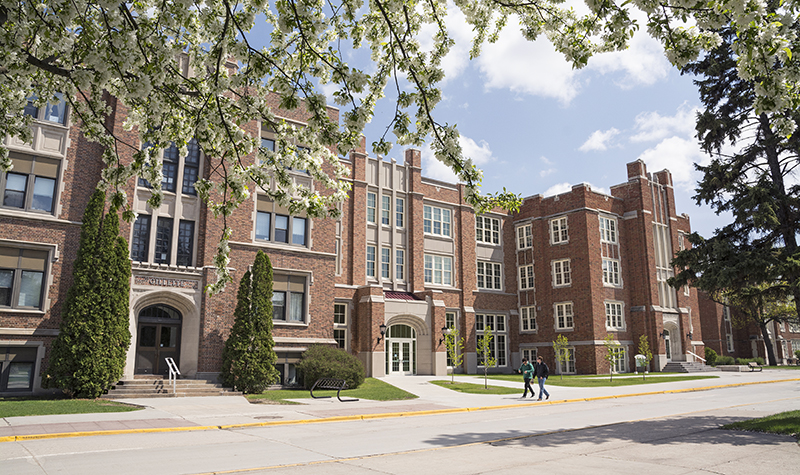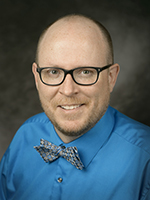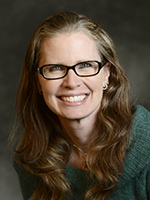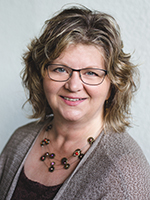Faculty publish remote-learning advice for parents
Top 10-style list features tips and tricks from North Dakota’s experts in teacher training and education research

Across North Dakota and the rest of the country, schools are transitioning students to home-based learning.

Himself a father of two children in K-12 classrooms, Marcus Weaver-Hightower, professor of educational foundations & research at UND, realized parents everywhere were suddenly faced with the prospect of keeping their kids’ educations on track.
“People are struggling right now on a lot of different levels,” said Weaver-Hightower about the circumstances caused by the coronavirus pandemic. “Parents might feel as if they have to become strict schoolteachers, and I don’t think they, or their children, want to have that kind of relationship.”
While there is certainly a need to help young people stay on board with classwork, Weaver-Hightower knew that the collective expertise at the UND College of Education & Human Development could be of much-needed service during such unusual times.
So, he collected – and distributed for publication – a range of tips, tricks and sage advice from some of the state’s leading teacher-trainers and education researchers. The guide now has been written about and published in the Grand Forks Herald and made available to other Forum Communications newspapers. It is also available as a resource in UND’s Coronavirus Updates blog.
Learning environments at home
Cindy Juntunen, dean of the College, said in moments like the one we’re all facing, “We have to reach out and help each other. That’s just part of being a North Dakotan.”
Cheryl Hunter, chair of the Department of Teaching, Leadership & Professional Practice, emphasized the imperative for a state institution such as UND to support communities at the local, state and regional level.

“It’s essential that we reach out to parents and to community members to help strengthen and provide resources during this period of massive disruption,” Hunter said. “Family and community engagement is at the heart of what we do.”
What’s critical for parents, kids and teachers alike, said Juntunen, is that now is a great time to work on being patient with each other, and providing structure where it might feel absent.
“Kids benefit when they know that the adults around them are able to have plans and make plans, but also to be calm when plans don’t go the way they think,” Juntunen said. “That teaches kids valuable lessons about resilience and coping, which are relevant qualities for all of us right now.”

Other “top 10” pieces of advice from CEHD faculty include creating learning environments around the house in daily activities such as doing laundry or cooking dinner. Young children can learn about colors, counting and following directions, and teens can start acquiring life skills for when they’re eventually on their own.
It’s beneficial to give kids some choice in planning routines, as it can help provide a sense of control and motivation toward schoolwork.
But, most importantly, the world is stressful enough right now. Parents should approach homeschooling with self-compassion, humor and the mindset that perfection is not the goal for helping children learn.
“Also, lean on the help and expertise of your children’s teachers, administrators and counselors,” writes Weaver-Hightower in introducing the list. “They have been working heroically to quickly compile resources and get technology access to every child. … Don’t be afraid to be in contact for advice or just saying hello.”
Stay active!
As a leading researcher in children’s physical education and fitness, Grant Tomkinson, professor of kinesiology, made a crucial contribution to the dialogue: “Movement, movement, movement!”

“Most kids at school from elementary through high school have a meaningful part of their weekly physical activity delivered through the school,” Tomkinson said. “Now, when they’re at home, chances are they’re not outside and they’re not sufficiently active, even with incidental activities such as walking from one classroom to another or walking up stairs.”
In a shelter-at-home environment, Tomkinson implores everyone to reintroduce physical activity. Staying active is important for all aspects of the body, but most-so for the brain.
“When we get blood circulating through the body and brain, we tend to feel better about ourselves,” Tomkinson said. “We tend to have a hormone rush that uplifts us; it also translates well to good cognitive and academic performance.”
What’s been useful for a long time in his line of work is the rule of 30+2 and 60+5. What people should try to do is break up the day and “snack on bite-sized chunks” of physical activity. Every 30 minutes, do two minutes of something, even if it’s just walking around or stretching – break out of the sedentary cycle.
“In the College of Education & Human Development, we’re leaders in this space,” the kinesiologist remarked. “We’re at the forefront of the research environment, and it’s imperative that we try to translate the lessons we learn to help teachers and, in this case, students and their parents to use them. They’re the ones who now have to act it out.”
Other contributing faculty, across the College, included (in alphabetical order): Zarrina Azizova, Sonja Brandt, Bridgette Campoverde, Bonni Gourneau, Shannon Grave, Sherry Houdek, Gail Ingwalson, Naomi McGaughey, Judy Milavetz, Katherine Nelson, Diana D’Amico Pawlewicz, Robert Stupnisky and Kristen Votava.



